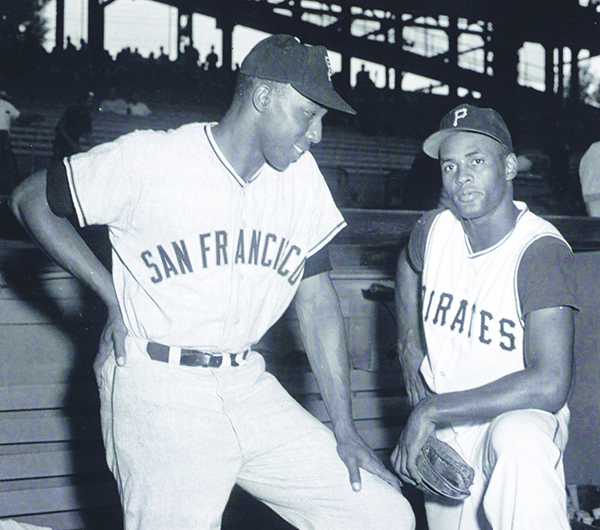By Shirley Hawkins
Contributing Writer
LOS ANGELES — In honor of Black History Month, the Getty Gallery at the Los Angeles Central Library, 630 W. Fifth St., in downtown Los Angeles is exhibiting “Barrier Breakers: From Jackie to Pumpsie, 1947-1959” that highlights the history of baseball’s Negro Leagues.
The exhibit’s title refers to Jackie Robinson, who broke Major League Baseball’s color barrier in 1947, and Pumpsie Green, who debuted for the Boston Red Sox in 1959. The Red Sox were the last Major League team to integrate.
On exhibit until Feb. 19, the traveling exhibit developed by the Negro Leagues Baseball Museum in Kansas City, provides a timely history lesson that chronicles the resilience of the ballplayers in the Negro Leagues.
Despite a color barrier that denied them the opportunity to play in the major and minor baseball leagues for 60 years, dozens of African American teams were formed across America by the 1880s to overcome the challenges of societal prejudice and social injustice.
Focusing on different decades, the exhibit highlights the various obstacles players of color faced, how they overcame the challenges of prejudice and social injustice and how their talent, passion and perseverance changed Major League Baseball forever.
“The exhibit also features free-standing panels that chronicle the history of the leagues and the bios of the famous players as well as the jerseys they wore that represented their respective teams,” said Susan Lendroth, public relations specialist for the Los Angeles Public Library.
A number of talented players are also featured, including Josh Gibson, Satchel Paige, Cool Papa Bell, Martín Dihigo, Turkey Stearns, Judy Johnson, Oscar Charleston and many more who become household names for both Black and white baseball fans across America.
The exhibit also features the societal attitudes toward segregation and integration in all walks of American life and the groups that were organized to maintain the status quo as well as those who advocated equality in all aspects of life for every American citizen.
The Negro National League remained strong until the Great Depression, which destroyed all but a few independent clubs by the early 1930s. Organized Black baseball rose again in 1933 with the founding of the new Negro National League that was soon followed by the Negro American League.
Negro League baseball remained popular through the 1930s and early ’40s, with an estimated three million fans coming to ballparks during the 1942 summer season.
Despite their victories on the baseball field, young Black and Afro Latino soldiers who were shipped abroad and fought in World War II for democracy found that when they returned home, they were once again faced with the societal racism and inequality that is also illustrated in the exhibit.
A new era began in 1946 when Jackie Robinson was signed by Brooklyn Dodgers general manager Branch Rickey.
Rickey anticipated a backlash when Robinson broke the color barrier, and he implored Robinson to resist the temptation to lash out at the abuse he would inevitably endure.
Rickey play-acted several roles — from a belligerent hotel clerk to a hostile waiter to a combative opposing player — to try to goad Robinson into snapping and subjected Robinson to the vilest taunts imaginable.
“Do you want someone who would not have the courage to fight back?’’ Robinson asked Rickey.
“I am looking for someone with courage not to fight back,” Rickey replied.
Rickey left it to Robinson to decide whether he could summon the self-control and discipline that would be necessary to ignore the taunts and break into the major leagues.
Robinson broke the Major League Baseball color barrier and made his historic debut for the Brooklyn Dodgers the next year. He was followed by Larry Doby and Satchel Paige who quickly followed Robinson into the Majors.
Robinson’s signing with the Brooklyn Dodgers proved to be a monumental watershed moment in sports history.
After Robinson made his debut with the Dodgers, 17 African American ballplayers integrated big-league clubhouses and 15 other teams integrated their ball clubs during the next 12 years.
In addition, other professional sports such as basketball, football and hockey started to integrate their leagues as well.
The Negro Leagues dissolved soon after more and more of its most talented stars were finally admitted into Major League Baseball.
Although the Negro Leagues were all but disbanded, their creation had done its job: African-American ballplayers had proven that they could play on even terms with their white counterparts — and challenge Major League Baseball at the box office, too.
“The Los Angeles Public Library is proud to host this wonderful exhibit, “Barrier Breakers,” City Librarian John F. Szabo said, “and we plan to share it with numerous school groups and community organizations to make more widely known this inspiring chapter in American history. By making it accessible at the Central Library, all Angelenos can now see this exhibit for free.”
“The exhibition honors the individuals who, through their dedication and will, broke the color barrier in Major League Baseball and changed the trajectory of our national pastime and America forever,” Central Library Director Kren Malone said. “Making this exhibition available to anyone visiting Central Library serves our goals to educate and inspire current and future generations.”
For more information, visit lapl.org.
Shirley Hawkins is a freelance reporter for Wave Newspapers. She can be reached at metropressnews@gmail.com.













